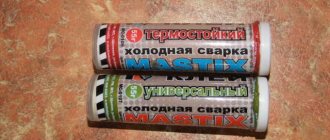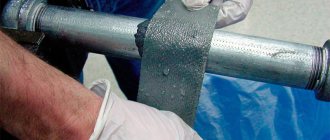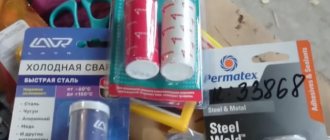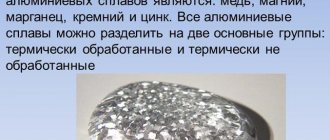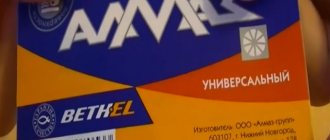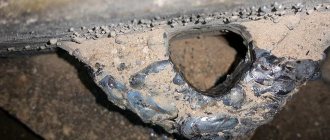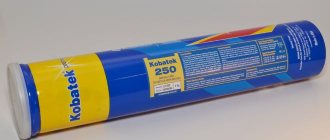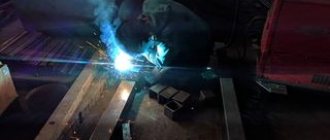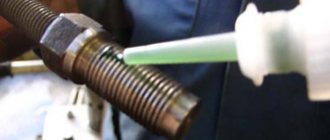Welding an engine with argon includes a whole range of work, since this technology allows you to weld almost all metals used in this unit: from aluminum to stainless steel or cast iron. Thus, the list of engine elements that can be repaired by welding is very extensive and includes:
- cylinder blocks;
- cylinder head;
- intake and exhaust manifolds;
- pipelines;
- valve guides, seats and inserts;
- pumps;
- pistons and piston pins.
How to weld an aluminum engine block yourself
In the article, we can see several damages to the aluminum alloy cylinder block in the car.
From them you can see how, in some cases, restoration work is carried out on a cylindrical block. Damage to the cylinder block of the ZMZ-24 engine
The damage consists of a crack in the outer cooling jacket at the corner of the block. One end of it goes to the thread hole for the head mounting pin.
The technical requirements for welding are to ensure the strength and tightness of the welding joint.
The most appropriate solution would be to repair the damage using argon arc welding. It is necessary to cut a groove along the crack and clean the metal surface until the oxide film is completely removed, that is, completely clean metal should appear before welding. Immediately before starting welding around the crack, it is required to heat it to a temperature of 250 - 280 degrees Celsius. This operation can be carried out using the flame of a gas burner, on which a tip number 4 or number 5 is installed. The metal can be heated to the required temperature in 1.5 - 2 minutes. To prevent possible warping of the metal under the cylinder liner, a technological sleeve is inserted into the hole.
For welding, torch number 2 is used, in which a tungsten electrode with a diameter of 5 - 6 millimeters is installed. The welding process is carried out at a current of 240 - 280 Amps. The crack can be welded from either end, but it is best to start welding from the threaded hole and then move to the side surface of the block.
The possible formation of pores in the weld metal is a consequence of the ingress of scale into the weld pool, sucked from the internal cavity of the block. A weld containing pores must be remelted without adding filler material. In this case, the torch is given crescent-shaped movements across the seam or loop-shaped movements perpendicular to the plane.
Having finished welding the cylinder block, the welding site must be covered with asbestos to slowly cool the metal, thus avoiding sudden temperature changes. In order to fully ensure the tightness of the welding joint, the cylinder block should be crimped on a hydraulic stand, applying pressure to it under a pressure of 0.3 - .4 MPa.
In this case, the cylinder block was restored until all its operating functions were restored. The work required the use of argon arc welding, as well as the skill and experience of a welder, which are an indispensable tool when carrying out any welding work. From this example you can see that welding a cylinder block is not such a difficult job, but it does require care and effort, due to which the weld will become strong and durable.
Source
Cold welding of aluminum parts using special glue
Cold welding of aluminum parts, performed using a special adhesive composition, is a technology that allows you to obtain a permanent connection very quickly and without special surface preparation. Very often, this technique is used in cases where it is necessary to eliminate an emergency situation and quickly connect aluminum parts. Naturally, the simplicity of this technology allows it to be used most often at home.
Adhesive for fastening aluminum parts by cold welding
The special composition that is used to perform such welding is a two-component glue, produced in the form of mastic or a thick liquid. This glue (it can be purchased at almost any hardware store) consists of epoxy resin and steel powder, which serves to strengthen the joint being formed.
To improve the characteristics of the adhesive composition for cold welding (adhesion to the surfaces being joined, resistance to high temperatures and aggressive environments), special additives are added to its composition. Thanks to their use, the properties of the hardened adhesive composition often exceed the characteristics of the parts being connected in terms of strength and reliability.
Using two-component adhesive to fix the fitting in an aluminum alloy pipe
Any adhesive for cold welding - both liquid and in the form of mastic - consists of two components that must be mixed immediately before use. It should be borne in mind that it is necessary to apply the mixed composition within 20–30 minutes (after half an hour it begins to actively harden). After applying the adhesive composition to the surfaces of aluminum parts, they must be pressed together and kept in this state for 40–45 minutes. Complete hardening of the composition occurs within 2–2.5 hours.
In order to obtain a reliable connection in industrial or home conditions when using cold welding glue, it is necessary to first clean and degrease the surfaces to be joined. Using this method, you can not only join flat aluminum workpieces, but also weld small holes and cracks, spending a minimum of time and effort. The parts connected using cold welding adhesive withstand any mechanical stress well, except for tensile loads.
Cold welding repair of a broken car oil pan
The use of this method of cold welding of aluminum allows you to obtain strong and reliable connections, but has a number of limitations that you need to be aware of.
So, it is not recommended to use glue:
- in places characterized by high temperatures;
- in those places that are subject to increased environmental safety requirements;
- for connecting parts whose operating conditions often change;
- for sealing vessels and containers under high pressure;
- for connecting parts operated in aggressive environments;
- for sealing pipes and vessels in contact with liquid food media and food products.
It should also be noted the advantages of using cold welding adhesive, which make it a very popular means of joining aluminum parts:
- elimination of oxidation processes at the junction of workpieces, which gives durability to such a connection;
- ease of use;
- minimum time required to form a permanent connection;
- low price of the composition and no need to use special equipment and energy resources.
A short review of cold welding compounds common on the domestic market, based on reviews of people who have used them in practice.
- PERMATEX Cold Weld An effective and highly versatile adhesive that can be used with a variety of materials. Excellent resistance to pull-out and shear loads during testing.
- "WURTH Liquid" Excellent for working with metal parts.
- “Abro Steel” is well suited for repairing liquid storage tanks due to its high ability to ensure tightness.
- "Titan" Affordable price, excellent resistance to mechanical loads.
- “Cold Weld PERMATEX” Quite a popular composition that has earned a lot of positive reviews.
How to weld an aluminum engine block
The cylinder blocks of the ZMZ-53 engine are made of AL-4 aluminum alloy . Welding this alloy has many features that create some difficulties during welding. The main difficulty is that during the welding process, aluminum, when interacting with oxygen, combines and forms an oxide film, which has a higher melting point, unlike pure aluminum. Being on the surface of the weld pool, aluminum oxide makes welding difficult . It is also worth paying attention to the fact that welding aluminum alloys can be difficult because the metal has high thermal conductivity, and at elevated temperatures is quite fragile, which, if certain requirements are not met, can lead to the formation of cracks on its surface.
Welding of the engine cylinder block must be done with the neutral zone of an oxy-acetylene flame. You can also use a flame with excess acetylene.
Welding work on the cylinder block is carried out by drilling into the surface of the metal edges . The crack area is cleaned of various types of contaminants using an abrasive wheel or a special metal brush. After this, the cylinder block is heated to a temperature of 250 - 300 degrees Celsius. To carry out this process, the block can be placed in a special oven for heating or heated using a burner flame. When heated, the crack should be in a horizontal position.
On both sides of the crack there are pieces of filler material, which are rods of aluminum alloy AL-4 , from which the block itself is made . The burner flame is directed at the cracks, into which a steel hook is inserted. After the metal begins to melt, the hook is immersed into the depth of the metal and with its help the molten metal is mixed.
Thus, the film of refractory oxides is destroyed, and the oxides themselves are removed from the weld pool, which makes the weld seam strong and durable. After heating the weld pool, filler material is introduced into it. It is introduced without removing the burner flame, and fluxes are used to dissolve the formed oxides.
Let's sum it up
As you can see, the cylinder block is welded with argon most often for sale. This is not the most reliable option for repairing a power plant. But there are masters who can do everything quite efficiently. Often, after a visit to them, the owners decide to sell the car, as they are constantly worried about the presence of handicraft interference in the operation of the engine. Any sound becomes scary, it seems that the engine is now going to shatter into small pieces. Therefore, when repairing a car for your own further use, it is much better and easier to perform a normal repair with replacement of the cylinder block.
When making repairs for sale, it is better to refuse any work altogether, simply discounting the price to the buyer for the amount of repair work. If the new owner wants to cook the engine with argon, that will be his problem. You will come out of this situation fairly honestly with an untarnished reputation. You should not carry out cheap argon welding in a garage car service, and then quickly go to the car market in the hope of selling the car and forgetting about all these problems. Through mutual scams, car owners have already made the car market a dangerous place where they can lose all their money. How do you feel about repairing unit housings and gearboxes using argon welding?
What are internal combustion engine blocks
The engine cylinder block is cast from cast iron or aluminum alloy. The body has holes for liners or there is a monolithic insert with those for pistons. Inside the part there are ducts for antifreeze and oil; on the lower part there are beds for the crankshaft bearings. The unit absorbs force loads and has bosses for installing cushions necessary for installation in the engine compartment. On the outer part there is a platform on which the serial marking is stamped or otherwise applied (information about this is entered into the PTS and traffic police information databases).
Features of the material
For the manufacture of parts use:
- Aluminum alloys cast under high pressure (containing silicon, copper, manganese and magnesium), allowing to reduce the weight and dimensions of the power unit. Inside the body there is a cast iron insert with cylinder mirrors. It is impossible to restore aluminum components with thin walls using thermal methods. In case of mechanical damage, the purchase of a new unit is required.
- Gray cast iron (iron with a carbon content of 2.14% and with alloying additives). The metal is used for some engines of domestic and foreign production. The crack can be welded with special electrodes. If the damage has affected the crankshaft bearings, the mounting surface of the head or the mirror, then repair is impossible.
Welding an engine block with argon - does it make sense?
Author: Dmitry Sapko
There are different types of car engine repairs. You can simply use recovery after the breakdown of some internal and peripheral parts. And it is possible to restore after serious damage. These types of breakdowns include cracks in the cylinder block, chips in functional areas of the unit and various other features. With such breakdowns, it is simply impossible to operate the power unit, otherwise it may rupture during the process of pressurizing the chambers. There are two options for getting out of the situation. The first is replacing the damaged part. You need to select a suitable version of the engine block or a specific part; this can be done by disassembling, but with the help of a good specialist. This way you can make a really high-quality selection and buy reliable spare parts for restoration.
Properties and weldability of cast iron
Due to the increased carbon content in welds, pores filled with carbon monoxide are formed. Voids reduce the mechanical strength of the cast iron structure, in which cracks appear. The metal is characterized by rapid cooling. Due to temperature differences, internal stresses arise and various modifications of crystal lattices are formed, leading to the appearance of faults. Welding requires special electrodes and requires uniform heating and cooling of the cylinder block.
The main reasons for the formation of cracks
Common causes of damage to a housing part during operation:
- a broken connecting rod that pierces its side surface;
- freezing of water poured into the cooling system;
- overheating of the internal combustion engine, leading to thermal deformation and destruction of structural elements;
- cyclic shock loads (for example, due to operating a vehicle with damaged support pads).
One of the main reasons for the formation of cracks is damage to the connecting rod.
When welding, cracks form when the walls of a cast iron part are suddenly heated or cooled. To prevent defects, the block is slowly heated and heat is supplied to it during welding. To prevent a decrease in the concentration of carbon, which combines with atmospheric oxygen and forms gas, a protective environment (for example, argon or fluxes) is used. To prevent hydrogen from entering the seam (from air or electrode coating), a protective gas atmosphere is used. Cracks can also form if the flux is incorrectly selected.
ICE welding methods
Several technologies are used to restore damage:
- hot processing;
- semi-hot exposure;
- welding without preheating.
hot
The hot process means welding with pre-heating of the workpiece with a gas torch to +600°...+700°C. After the seam is formed, the block is slowly cooled in an oven, minimizing the risk of bleaching (the appearance of a hard and brittle phase) and the formation of gas pores. To perform the work, special equipment is required, so the technology is not used in domestic conditions. The seam is characterized by increased mechanical strength (if the requirements are met). It is allowed to repair damage in hard-to-reach areas.
Semi-hot
For massive body parts, complete heating is difficult, so they are processed using semi-hot welding technology. The area around the seam is heated to a temperature of +300°...+400°C, and then cooled evenly. Increased wall thickness and greater weight of the structure reduce the risk of new cracks due to thermal stress or the formation of white cast iron crystals. The technique is designed for the use of special equipment and is not used in domestic conditions.
Stress relief and cooling
Strengthening the weld is also highly recommended to relieve stress. This is done by lightly tapping the bead with a medium-heavy hammer, such as this ball hammer.
The last critical part is cooling. Cast iron needs to cool very slowly. Ideally, it should be buried in sand or wrapped in thermal blankets, but on a normal summer day a few regular blankets will suffice. This part is a little annoying as catastrophic failure is possible at this stage. In any case, we never heard the characteristic "ringing" sound of cast iron splitting.
Preparation before the welding process
At the preparatory stage, it is necessary to clean the mating surfaces from traces of paint and oil to improve the visibility of the material. Sharp corners, which act as stress concentrators, are not allowed. The edges must be cut with an abrasive tool (for example, files or an electric carbide cutter). The recesses for the future seam should take on a U-shaped configuration with rounded transitions. At the ends of the cracks, it is necessary to drill holes to the entire depth of the wall (channel diameter - 5-6 mm).
If the cracks are located in hard-to-reach places, then it is necessary to cut out technological channels to provide access (additional ones reduce the rigidity of the cylinder block). After completing the work, the holes must be sealed (welded or closed with a screw plug). Before work, it is important to assess the labor intensity and cost-effectiveness of restoring the unit. In some cases, it is advisable to purchase a new part and make appropriate adjustments to the documents (indicate the changed identifier of the license plate unit in the PTS).
Welding technology for internal combustion engine blocks
For cold welding you need:
- Install the assembly on the mounting table. To weld a fragment, you need to combine the parts and secure them with clamps. There is no need to clean the surfaces from traces of oil or antifreeze: foreign liquids will burn out under the influence of high temperature from the burning arc.
- Fuse the metal with an electrode along the edges of the fracture, avoiding overheating of the main part of the block to a temperature above +80°C.
- Use short stitches to fill the seam, hammering the roller over the hot material. The sections should be up to 40 mm long and located at a distance from each other (to prevent overheating of the unit).
- Turn the product over and weld using a similar technique.
Point technology
This technology, which involves overlapping aluminum parts, is the most common method of cold welding of this metal. The workpieces to be joined are compressed at individual welding points, for which a special punch is used. According to this technology, parts are predominantly connected by several welding points located at a certain interval relative to each other.
Cold spot welding diagram
The quality of cold welding performed using spot technology directly depends on the degree of deformation of aluminum in the area of the weld spot. In numerical terms, this parameter characterizes the relationship between the thickness of the parts being connected and the depth to which the punch is pressed into the metal. There are standards according to which this parameter for aluminum should be 60–70%, and for alloys based on this metal – 75–90%.
Cold spot welding, which can be used to join fairly large sheets of aluminum and alloys based on this metal, has a number of advantages.
- The parts to be connected do not require preliminary fixation in special clamping devices.
- Aluminum is deformed in very small local areas - weld points.
If you have a mechanical device capable of creating significant pressure, cold welding using this technology can be performed at home.
Welding mode parameters
Welding current parameters are selected depending on the type and diameter of the electrodes. Information about this is indicated by manufacturers on the packaging. For example, for 3 mm the parameter ranges from 65 to 80 A for TsCh-4 products, and when using OZZHN-1 the value increases to 100-120 A. When using electrodes with a diameter of 5 mm, the current strength is 130-150 A and 160-180 A respectively. If the regime is violated, material is ejected from the weld pool and the workpiece overheats, leading to the appearance of cracks.
Welding aluminum with an electrode at home
Welding aluminum at home with electrodes involves several different methods.
The most common method is inverter welding, analyzed above.
Also, when working with consumable electrodes, welding transformer . The technology is practically no different from steel welding, but the seam may not be of the highest quality.
In addition to using tungsten electrodes in argon arc welding, carbon rods . The shielding gas supplied from the burner can be argon, acetylene, propane or others. It all depends on whether the performer has them. The welder will also need a powdered flux that prevents the electrode from sticking and removes the oxide film. The arc power source can be a welding inverter or a transformer. In some cases, to stabilize the working process, a magnetic field is required, which is created by the solenoid.
Preparing metal for welding
Regardless of the welding method used, it is imperative to carry out preparatory procedures for the working surface: Filler materials and product edges must be cleaned of dirt, oil and grease .
Chemical treatment includes several procedures:
- degreasing the surface with a solvent: white spirit, acetone, aviation gasoline or any other;
- etching using concentrated alkali, duration – 2 minutes;
- the metal must be washed with cold water;
- passivation with 30% nitric acid solution for two minutes;
- rinsing with water again;
- drying.
If aluminum welding is carried out with uncoated electrodes, then edge cutting is carried out when working with products with a thickness of more than 4 mm. The use of consumables with coating involves cutting edges when connecting parts to walls with a thickness of over 20 mm. The ends of thin aluminum sheets (no more than 1.5 mm) must be beaded.
Using a file, a brush with stainless steel/steel bristles (in the picture) or sandpaper, the surface to be welded is cleaned.
Welding process
After preparing the product, the welder can begin the main work.
The process of welding aluminum and its alloys includes several important stages:
- heating the product to a temperature of 150°C;
- setting the welding machine to the required mode;
- excitation of the welding arc , depending on the welding method, can be carried out by contact and non-contact methods;
- creation of a weld pool , the formation of which occurs in a few seconds (the required time is approximately equal to the thickness of the part in millimeters); a spot of molten aluminum with a mirror surface should appear in the heating zone;
- after the formation of the pool, you can begin to supply the additive and perform welding;
- welding is carried out with an arc of 2-6 mm, using direct current of reverse polarity.
Video
Great demo video from Zeller that gives an idea of the process.
Safety precautions
Welding various aluminum structures involves providing protection for the performer. To do this, you need to use special equipment : a mask, mittens, rubberized shoes, asbestos or tarpaulin, sheet iron.
It is necessary to isolate all elements of the electrical circuit.
Do not carry out work in rooms where flammable objects .
It is necessary to have ventilation in the room to avoid gas poisoning.
Safety precautions MUST be followed as there is an increased risk of injury when working at home.
Selection of electrodes for welding
Common types of electrodes for welding cast iron (according to Russian standards):
- TsCh-4, designed for welding without heating the structure. They have a diameter of 3, 4 and 5 mm. The composition of the deposited metal includes up to 0.25% carbon, manganese, vanadium and silicon are present. The products have a base coating; surfacing 1 kg of material will require 1.4 kg of electrodes. It is allowed to use DC or AC equipment (reverse connection).
- OZCh-2, having an acid coating. They are designed for sealing cracks and surfacing material on products made of gray or ductile iron. Designed for welding with short beads (length from 30 to 50 mm) with forging immediately after extinguishing the arc and cooling under the influence of atmospheric air. Before work, they require calcination at a temperature of about +200°C for 1 hour. The rod consists of copper with the addition of iron and nickel (10% and 2% respectively), it contains manganese and a small amount of silicon.
- OZZHN-1 with basic coating. They provide a deposited material that matches the shade of gray cast iron. Designed for cold welding with short beads with forging and gradual cooling. Designed for direct current equipment with direct polarity of connection. To seal large faults, such electrodes are used in conjunction with MNC-2. Their rod consists of an alloy of nickel with iron and additives (carbon, manganese, silicon and traces of aluminum).
- MNC-2 are designed to operate without preheating the workpiece. They are used for welding defects in gray cast iron blocks. Provides a weld material with increased hardness. Welding requires DC equipment with reverse polarity.
In addition to Russian brands, there are analogues produced by the Swedish company Esab or the German factories Kjellberg or Zeller. For example, Zeller's 855 electrodes have a bimetallic core (nickel-iron alloy) and a graphite-based base coating. They are designed for welding cast iron without heating the edges (connecting steel elements with a cast iron base is allowed). Initially created for the restoration of crankcases of power units or transmission units.
Difficulties of welding aluminum
The main difficulties encountered when welding aluminum.
During welding work, the work product heats up to a certain temperature and begins to change its color.
This happens with copper or iron - the most popular metals for the production of household items. Changing the shade helps the performer to correctly regulate the process, understand whether the heating is sufficient, determine whether the seam has been “sealed” or whether heat treatment needs to be continued. But aluminum does not change color .
Therefore, the welder cannot visually evaluate the result. The high thermal conductivity of this metal requires a limitation on the duration of thermal exposure. Exceeding the duration of exposure to high temperatures can lead to deformation, cracks, bulges and other defects.
The peculiarities of welding aluminum and its alloys are explained by a whole range of special properties that the metal has:
- The surface of this material is always covered with an oxide film , which has a high melting point - about 2000°C. The metal itself melts at 660°C.
- Drops molten aluminum
, formed during welding in the working area, are immediately covered with an oxide film, which prevents the formation of a continuous seam. To prevent this effect, it is good to use argon gas, which reliably protects the welded zone from interaction with air. - The high fluidity of aluminum in the molten state seriously complicates the formation of a weld pool. Therefore, the technology for welding aluminum requires the use of special linings that remove heat from the welding zone.
- Aluminum contains dissolved hydrogen , which tends to escape into the atmosphere. This promotes the formation of pores and crystallization cracks.
- Aluminum has a fairly high coefficient of linear expansion . Because of this, significant shrinkage occurs when the metal hardens.
- Due to the high thermal conductivity of this material, welding should be carried out using significant amounts of current.
- An important feature is that welding aluminum is often complicated by the fact that it is difficult for the performer to determine the brand of alloy from which the welded products are made. This complicates the choice of connection mode and method of its implementation.
burns on the back side
For household aluminum welding, MMA and TIG . Welding workpieces 5-7 mm thick. performed by direct current of reverse polarity. For thick-walled parts, preliminary preparation will be required. Welding aluminum with an electrode at home includes the following steps:
- thorough cleaning of workpieces from the oxide layer;
- degreasing is carried out using a solvent;
- to obtain a more durable and uniform connection, edges of products with a thickness of more than 5 mm. need to be removed at an angle of 45 to 65 degrees;
- the coating of electrodes for aluminum is characterized by active absorption of moisture, so calcination should be performed before welding;
- the surface to be welded must be heated to 250°C , which promotes more efficient melting of the oxide film;
- The current strength depends on the thickness of the walls of the product, the parameters of the seam, as well as the composition of the base metal.
Important! The weld seam should not be thick, otherwise it will be porous and cracked. Therefore, when working with massive parts, several passes should be made.
More detailed information is presented in the article “Welding aluminum with electrodes”.
Argon arc welding with a non-consumable electrode requires large financial costs. However, the quality of the seam is much better compared to the MMA connection. Home TIG welding technology includes the following operations:
- the device must be equipped with an oscillator (a device that ensures excitation and stability of the arc), which improves the parameters of welding and melting of the oxide layer;
- To avoid excess gas consumption, it is necessary to set the tungsten electrode to 5-6 mm. from the tip;
- argon is supplied at a flow rate of 5-8 l/min, after which current is supplied with a slight delay;
- after the formation of the weld pool, the welding wire melts progressively;
- welding is carried out using pulsed alternating current.
There are also general rules for welding aluminum that are recommended to be followed for any method:
- welding is performed from right to left ;
- the arc length should be 1.5-2.5 mm;
- the filler material is fed in short, progressive and reciprocating movements ;
- an angle of 90 degrees between the electrode and the wire
- It is not allowed to perform transverse vibrations with a tungsten electrode;
- Thin aluminum is welded with a copper or iron backing to dissipate heat and prevent burns.
burn-through
Is it worth trying?
Welding aluminum at home has a number of advantages :
- saving financial resources, this advantage is especially important for performers who have the necessary equipment at their disposal;
- instant results that can be checked immediately;
- the ability to use improvised means;
- no special requirements for seam quality.
However, it is worth noting the disadvantages :
- when welding aluminum at home, the performer will receive a connection of lower quality;
- sometimes difficulties arise when choosing filler material;
- at home it is difficult to use advanced technologies that are used in modern industries;
- it is more difficult to comply with safety regulations;
- electrodes may be stored in inappropriate conditions, they may become damp or deteriorate;
- lack of precise methods for quality control of the finished connection.
Safety precautions
During the welding process, safety precautions must be observed:
- use a protective shield, clothing and gloves made of non-flammable materials;
- connect the equipment to a working AC network;
- use a welding machine with a grounding loop;
- do not use cords with damaged or missing insulation (the length of connecting wires should be no more than 10 m);
- equip the workplace with ventilation and provide protective screens;
- when welding in a room with high humidity, use a rubber mat;
- do not work where flammable liquids (for example, motor fuel or oil) are stored;
- Use special clamps to hold parts.
Equipment and materials for welding
Work must be carried out in a protective suit.
To carry out the work you will need:
- standard welding machine or inverter with the function of adjusting the current in the circuit;
- ferronickel electrodes (for example, model 855 manufactured by Zeller);
- metal brush and hammer to remove scale and remaining protective coating;
- protective shield and welder's suit to prevent burns from flying drops of metal and scale.
We recommend that you read
Muffler welding
Possible difficulties
Problems that arise when restoring parts:
- The damage affects the threaded holes intended for mounting the sensors. After repairing the fracture, it is necessary to drill the channel and restore the thread, but mechanical stress can destroy the seams. In this case, you will have to refuse to install the sensor or purchase a new unit.
- The crack runs through the cooling jacket or the engine oil supply passages. When carrying out welding work, complete or partial overlap of sections occurs. Such repairs lead to accelerated engine failure (due to local overheating or oil starvation).
- The resulting weld is not airtight, so a layer of epoxy resin must be applied. Before treatment, clean the surfaces from carbon deposits and degrease (for example, with paint solvents). After polymerization, epoxy resin does not allow liquid to pass through, but cannot withstand vibration loads and temperatures above +120°C. After welding with a ferrocopper electrode, the seam is treated with a 10% ammonium chloride solution for sealing. The reaction products fill the pores and reduce the risk of liquid leakage.
Replacing the cylinder block and abandoning welding is the right decision
Any welding, even by the most professional performer, will not be as high quality as installing a new cylinder block. When there is a crack in this unit, the component parts of the unit quickly break down and everything fails. Even with professional welding, it is impossible to maintain all factory dimensions down to the last micron. The cylinder block is replaced as follows:
- Based on the make and model of the engine, the specialist searches for spare parts, selects all peripheral parts that will also have to be changed, and forms a budget;
- Also added to this budget is the cost of work, which each master evaluates in his own way, but it is better to contact a professional car service station;
- Next, the engine is disassembled, the problem and its effect on all other parts, such as pistons, connecting rods, rings and seals in the unit, are studied;
- a new cylinder block is installed, the necessary parts are assembled in the right place, and at each stage several checks are performed, which proves the quality of the part;
- After assembly, it is necessary to diagnose the power unit in different planes, then test drive the car with an understanding of all extraneous sounds and noises in the engine.
If a used cylinder block is being installed, special care must be taken during the engine testing and inspection processes. However, with professional selection of the part, no negative features of the operation of the power unit should arise. That is why replacement is the optimal process for such a breakdown. But welding is not always suitable, even if done professionally.
Help from specialists
If difficulties arise, it is recommended to contact specialized companies engaged in the restoration of parts made of ferrous and non-ferrous metals. After analyzing the damage, the repair price is calculated. It is necessary to compare the cost of restoration with the cost of a new unit. For a number of mass-produced car models (for example, from the VAZ plant), it is more cost-effective to install another unit (with simultaneous replacement of piston rings, liners and revision of the gas distribution mechanism) than to pay for repair services from a third party.
Additional Information
After completion of the work, the surfaces must be treated (for example, if any unit is being installed). In a workshop setting, a milling machine is used to level the plane; in a domestic situation, an angle grinder is used. At the same time, it is important not to damage the mating surfaces with high precision processing (for example, for installing a clutch bell, front cover or head).
Welding an automobile cylinder block requires a highly qualified worker. Mistakes made lead to a decrease in the strength of the assembly; with cyclic temperature changes (the part warms up to +90°...+95°C and cools down to ambient temperature), new cracks may appear. In case of a large area of damage, it is possible to install patches from a sheet of steel, which are welded into cast iron. The decision on the method of restoration and the feasibility of repair is made by the master, based on the qualifications and equipment available.
Source
Welding the cylinder head
Repairing a car engine housing may also involve welding the cylinder head (cylinder head). During long-term operation of a vehicle, cracks and chips may appear on the surface of the cylinder head, and depressurization of the cooling water jacket is observed, associated with long-term corrosion. Another reason for premature cylinder head failure is overheating of the car engine, which leads to disruption of the landing plane.
To diagnose cylinder head defects, it is dismantled and cleaned of dirt and oil. When cracks and cavities are identified, they are given a wedge-shaped shape and deepened with a milling machine to 6 - 8 mm in order to ensure uniform filling with filler material.
Before starting argon welding, the part is uniformly heated to a temperature of 200 °C - 250 °C. In the process, the filler wire is melted in the arc and fills the depressions in the surface. After completion of the work, the welds are cleaned.
To ensure a tight fit to the cylinder block, the lower surface of the cylinder head is milled; in addition, irregularities and sagging formed after argon welding are mechanically removed.
After completing the restoration work, our specialists check the tightness of the cylinder head using special equipment. Thus, we guarantee our customers high quality work!
